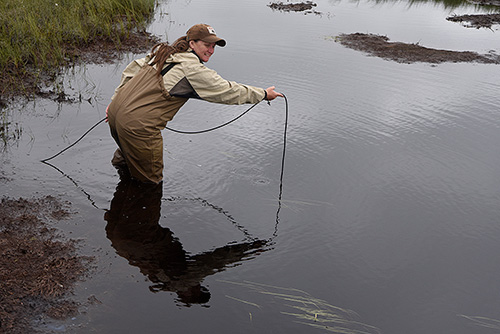 It’s a little cold and damp this morning, the tents and sleeping bags are warm enough but sleeping on the tundra may take a little getting used to; imagine laying seven large sacks of potatoes under your ground sheet with a few uneven giant sponges to fill the gaps in between and you may get some idea. Rather interestingly, the spongey bits flatten out a little and during the night both tent occupants slowly slide over towards the middle. I imagine by the end of the week that myself and my tent mate will become really CLOSE friends.
It’s a little cold and damp this morning, the tents and sleeping bags are warm enough but sleeping on the tundra may take a little getting used to; imagine laying seven large sacks of potatoes under your ground sheet with a few uneven giant sponges to fill the gaps in between and you may get some idea. Rather interestingly, the spongey bits flatten out a little and during the night both tent occupants slowly slide over towards the middle. I imagine by the end of the week that myself and my tent mate will become really CLOSE friends.
And now for the science! My individual research project investigates the release of mercury from thawing permafrost to the environment. There are vast stores mercury in arctic permafrost, which if released by the impacts of climate change, may have the potential to reach our water systems, enter the aquatic environment and possibly pollute the aquatic food chain. So, after informative conversations with the Polaris faculty and careful landscape assessment I have decided to collect water, soil and permafrost samples from features on sloping gradients, for example fens, ponds and small lakes in both burned and unburned locations. Logistically, for me it’s a daunting process to organise such a project as I have only just completed my first year at university; however, I feel really supported here, there are no tv’s/internet/telephones etc so we are able to get fully submerged in the science. I had an eventful time learning to use the aquatic sampling kits this afternoon. It took me back to my nursing days – lots of syringes, filters and needles to fill various vials and bottles. Not so easy to do though when you are in waders standing in an arctic lake with water up to your chest! Looking forward to more sample techniques in the morning and of course getting my hands on all those awesome data!
Highlights of the day: Sampling in an arctic fen with the water up to my chest, surrounded by thick vegetation and noticing golden spiders hanging out in the vegetation right next to me. Also, admiring the Arctic wildflowers and the berries that grow on the mosses, apparently they will be ready to eat next week!
– Polaris Project student Kelly Turner, Northumbria University, UK



